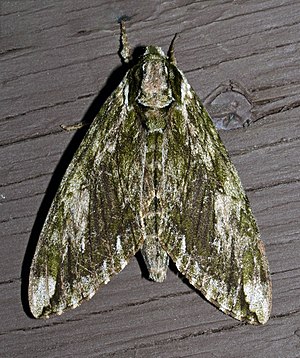Ceratomia hageni
| Ceratomia hageni | ||||||||||||
|---|---|---|---|---|---|---|---|---|---|---|---|---|

Ceratomia hageni |
||||||||||||
| Systematics | ||||||||||||
|
||||||||||||
| Scientific name | ||||||||||||
| Ceratomia hageni | ||||||||||||
| Grote , 1874 |
Ceratomia hageni is a butterfly ( moth ) from the family of moth (Sphingidae).
features
The moths have a fore wing length of 40 to 46 millimeters. They look similar to Ceratomia undulosa . However, fresh specimens have a greenish tinge. Like the similar species, Ceratomia hageni has a white discal spot and a white border on the outer edge of the forewing, but the white medial line is missing. Instead, it has a dark medial line, with the submarginal area and the wing tip also being drawn in white. The front edge of the forewings is more brownish in some individuals. The top of the hind wings is dark gray-brown with paler gray at the base and outer edge.
In the last stage, the caterpillars have a green to brown basic color. They are small with white dots so that the body appears rough. There are seven oblique stripes on the sides that extend from the front of one segment to the back of the following segment. The stripes have a very variable purple border towards the back. The fairly granular anal horn is almost white.
The pupa is similar to that of Ceratomia sonorensis . It is light red-brown and has a smooth, shiny surface. Grooves for the spiracles can be seen on the sixth and seventh segments . The trunk sheath is completely fused. The short, wide Kremaster ends in a rather blunt double point.
Occurrence
The species is mainly found along the Ohio River valley and Mississippi River valley in the central United States. To the north, the distribution extends into the southwest of Ohio and includes large parts of Indiana and the extreme southwest of Michigan and Wisconsin. In the south there is isolated evidence from Tennessee, the extreme northeast of Georgia and the Gulf States. In the west, the species is widespread in eastern Nebraska, Kansas, Oklahoma and Texas and is also common there.
Ceratomia hageni apparently only inhabits deciduous forests near watercourses.
Way of life
The moths fly to light sources at night. It is not known whether the moths ingest food.
Flight and caterpillar times
The flight times and generation sequences of the moths are not fully known. In Michigan, the species appears to fly in just one generation in late summer from mid-July to early September. In Indiana and Illinois, most records are made in June and July, but some are also known from August and early September. It is not known whether more than one generation is trained here each year. Further south, the species flies in at least two, possibly three generations in the Mississippi River valley from April to September.
Food of the caterpillars
The caterpillars apparently feed exclusively on the leaves of the milk orange tree ( Maclura pomifera ).
development
The females lay their eggs in small clutches of 4 to 12 pieces on the underside of the leaves of the host plants. The caterpillars live gregariously during the first two stages, from the third stage onwards they begin to divide and finally live solitary in the last stage. During the rest phases, the caterpillars often retreat to the trunk of the trees and hide in cracks in the bark. However, the young leaves at the end of the branches are eaten. Older caterpillars can fall from the tree if they are disturbed and remain motionless on the ground. Pupation takes place in a chamber several centimeters deep in the ground.
supporting documents
Individual evidence
- ↑ a b c d e f g h James P. Tuttle: The Hawkmoths of North America, A Natural History Study of the Sphingidae of the United States and Canada. The Wedge Entomological Research Foundation, Washington, DC 2007, ISBN 978-0-9796633-0-7 .
- ↑ a b c Sphingidae of the Americas. Bill Oehlke, accessed December 28, 2011 .
literature
- James P. Tuttle: The Hawkmoths of North America, A Natural History Study of the Sphingidae of the United States and Canada. The Wedge Entomological Research Foundation, Washington, DC 2007, ISBN 978-0-9796633-0-7 .

